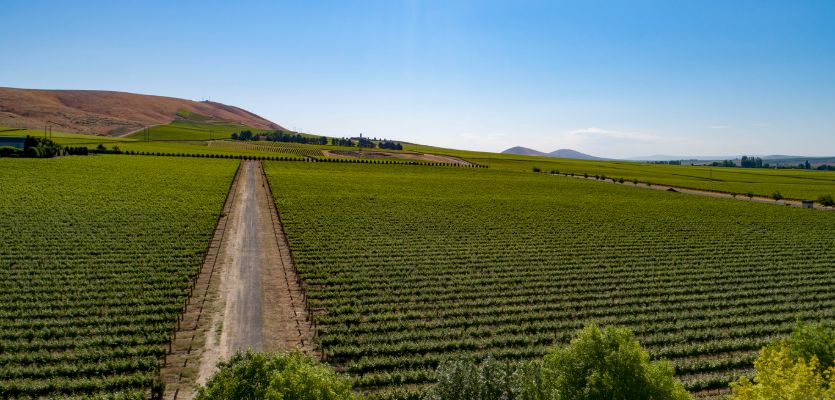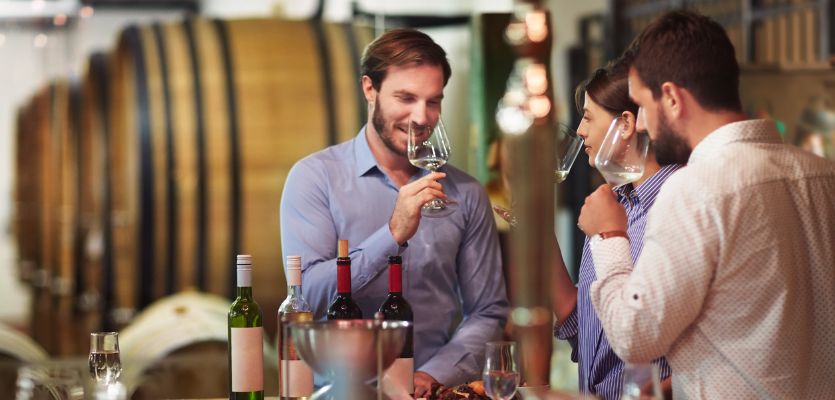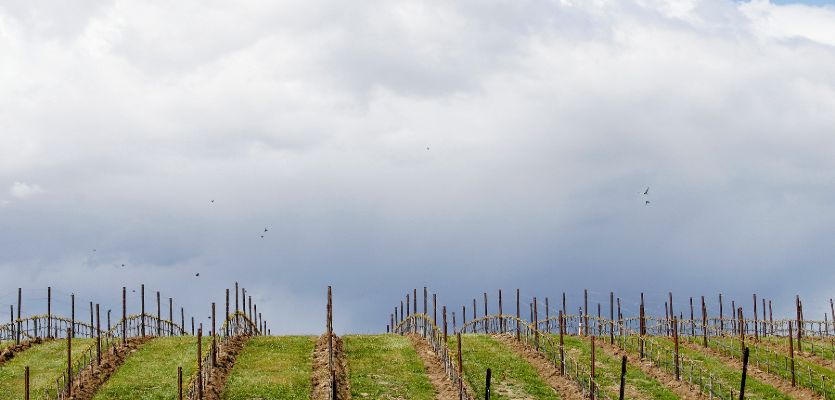Washington State Wine Country
Washington state is the second-biggest producer of wine in the United States. The state has vineyards and wineries spread all around the state, but the majority are located in eastern and southern Washington. Of these vineyards, the most well-known is located in Columbia Valley. If you ever decide to visit a vineyard during your travels to Washington state wine country, a trip to this part of the state is highly recommended.

Columbia Valley
It is located in the southeastern corner of the state and is home to the largest Washington state wine regions. Ninety-nine percent (99%) of the state’s grapes are grown in Columbia Valley. The Columbia Valley is traversed by the Columbia River and its tributaries. The Columbia Valley also neighbors other smaller Washington state wine regions, including Walla Walla Valley, Red Mountain, Yakima Valley, and Horse Heaven Hills, but it is the Columbia Valley itself that is the most important wine producer.
Washington state wine country is blessed with nearly 300 days of sunshine and despite the meager rainfall (6-8 inches per year, while Seattle averages 38 inches of rainfall each year), the soil receives a good runoff from the Cascade Mountains. The diversity of soil (sand and windblown silt), geographical landscape, and the angle of the sun in Columbia Valley is similar to the famed wine regions of Burgundy and Bordeaux in France. The hot summers, followed by cool evenings, allow for a long grape growing season, and, at the same time, the grapes ripen to maturity, while retaining their acidity, which is the key to making great aromatic fruity wines.
Grape Growing History
Grapes have been grown in the Columbia Valley for about 150 years, but the winemaking industry did not start until about the 1970s. Initially, the Valley was known locally for its white wines, but by the 1980s, the Valley started to make the “two reds” that made Columbia Valley most well known as one of the great Washington state wine regions. More than 70 grape varieties are grown in the Valley, but 80 percent of production is accounted for by Riesling, Syrah, Cabernet Sauvignon, Chardonnay, and Merlot. Other wines include Petit Verdot and Mourvedre, but the region is most famous for the rich aromatic Cabernet Sauvignon, which makes up for the majority of sales. The wine has won many local and national accolades for its taste and flavors.
Today, nearly two-thirds of the Valley’s vineyards make several varieties of red wines, including Cabernet Sauvignon. What makes the Valley's red wines stand out? The fruity flavors, balanced tannins, and sweet-tart acidity.
White wine drinkers should not feel left out, however, as the dry and arid climate of the Valley also results in outstanding fruity-acidic white wines, like Sauvignon Blanc, Semillon, Riesling, and the White Bordeaux blends.
Besides the famed red and white wines, the Valley also manufactures rose wines. These are most well-known for their crisp, delicately fruity, and herbal notes that make them easy to drink. While there are many types of rose wines produced, the most touted are the Grenache, Sangiovese, and Cabernet Franc.
Wine-Tasting Tours
Columbia Valley has many wine-tasting tours for visitors and locals alike. For maximum enjoyment, the wine-tasting tour should include several days of sightseeing in this magnificent part of Washington state wine country. The best time to tour and taste wine is late summer and early autumn when the weather is just perfect. There are ample hotels and motels to accommodate people with all budget needs, but you need to prebook as the Valley is inundated with visitors during the peak season. Unlike California, the tasting room fees in the Washington state wine regions are much lower and so is the cost of the wine. Some wine-tasting tours also serve appetizers and snacks. In addition, there are a variety of diners and restaurants in Columbia Valley. Probably the most famed winery in the Valley is Chateau St. Michelle and it may very well be worth your while to plan a stop there.
Today, these famed wines from the Valley can be purchased online from Pacific Rim and Company. If you have any questions, you may call our knowledgeable staff at 1-503-863-5454. Some of the great wines include the following:
- 2022 SWEET RIESLING
- 2018 SILVER TOTEM CABERNET SAUVIGNON
- 2018 SILVER TOTEM RED BLEND
- 2020 RAINSTORM PINOT NOIR ROSÉ
Blind Wine Tasting: Can You Taste Price?
The debate around the blind wine tasting game to assess the quality and price of the beverage continues. There are some wine drinkers who claim that blind wine tasting has no scientific merits and there are others who say the exact opposite. There are countless blogs on blind wine tasting games, and the majority indicate that most wine drinkers cannot judge the quality or the price of the wine when blindfolded. The overall conclusion of these reports is that (for most people) blind tasting is as good as guessing.

WINE-TASTING TRAINING
All these are anecdotal reports, of course, and have not been performed under strict scientific criteria. Now, there is a recent study published in the Journal of Wine Economics and discussed at Forbes.com, titled “Does blind wine tasting work?” The study was conducted at Oxford University, England. The participants underwent five weeks of training so that they could identify the structural elements of the wine, like alcohol and acidic levels, which can help differentiate the wine flavors. At the same time, some participants did not undergo such intensive training.
The overall conclusion was that when trained wine experts (sommeliers) were used for blind wine tasting, they were more accurate in judging the pricing than people with no wine tasting training. The reason why sommeliers were more consistently accurate in the blind wine tasting game was that they had been trained to categorize specific wine flavors.
The researchers claimed that the intensive training enabled the sommeliers to activate regions of the brain involved in high-level cognitive processes, such as behavioral strategies and working memory. On the other hand, novices tasting wine activated areas of the brain associated with emotional processing and taste.
THE CONCLUSION
What the researchers observed was that “…blind tasting training can improve accuracy in terms of guesses as well as structural elements.” But they did not observe “…any improvements in accuracy or within-group agreement when it came to guesses of country or region.” Results of the analysis showed that accuracy was increased for older wines compared to younger wines, and that sweetness, acidity, and color (red wine) were preferred to white wines. And, yes, the study showed that wine preference was correlated to price, the higher the price, the more positive the response. On the other hand, participants with no training preferred wines that: had more alcohol content, were more acidic and had fewer oak flavors.
WHAT DOES THIS MEAN?
Blind wine tasting is of importance as it removes all bias that an individual may have against or for a particular wine. The playing field is leveled for all wines to be judged by the same analytical method. For example, pricing is a major bias when it comes to wines. Most novice wine drinkers believe that an expensive wine must taste great, and a less expensive wine must not be as good. The reality is that (again, for most people) many less expensive wines can taste just as great, or even better, than expensive wines.
The authors concluded that as more educated young people have started to drink wine, manufacturers should take note that they have a low preference for oak flavors; instead, they should consider marketing red wines with more structure and maturity to this demographic.
If all this sounds confusing, consider purchasing a less expensive wine first to see if you like it. If you would like more information about wines, call the staff who is passionate about wine at 1-503-863-5454 and/or visit them online at Pacific Rim and Company. If you are looking for some great tasting, affordable, wines, then consider the following:
- 2018 RAINSTORM PINOT NOIR
- 2022 J RIESLING
- 2018 RAMOS VINEYARD GEWURZTRAMINER
- 2016 HAHN HILL VINEYARD ICE WINE RIESLING
Why Washington State is Currently Making Some of the Best Wine
When it comes to wines in the United States, most people think of California. But what many people may not realize is that Washington state wine is fast becoming a force to be reckoned with as well, producing a wide range of excellent world-class wines. Today, Washington state is the second-largest wine producer in the country, with annual revenues of $6 billion and growing. For decades, wine from Washington state has been underrated, but as a wine-growing region, it has been making an impressive range of top-notch wines that have left many wine drinkers clamoring for more.

WINERIES AND VINEYARDS IN WASHINGTON STATE
Unlike California, where winemaking is concentrated in a few regions, wine from Washington state is grown and manufactured in every corner of the state, totaling 14 regions, all working together to make a diverse number of Washington state wines for consumers. At last count, there were around 1,000 wineries across the state. From a variety of Riesling offerings to Cabernet Sauvignon, you can find all types of wines grown in Washington state. Unlike European or California winemakers, Washington state wines are considered “new” as the winemaking business is only about half a century old here. Washington state produces some excellent red blends and Riesling wines, which make up the majority of its sales both in and out of state.
WHY ARE WASHINGTON WINES SO PHENOMENAL?
For one reason, the sun’s angle shining down on the volcanic-rich soil is similar to that of some of Northern Europe’s greatest wineries because they share latitudes that are alike. In western Washington state, the Cascade and Olympic Mountain ranges prevent cloud roll-off into the Pacific Ocean, which creates what is known as the “Rain Shadow Effect.” Combine this with the fact that Washington state adds New World fruit to some of Europe’s traditional wines and you get a winning scenario. The typical weather pattern also includes sunshine for more than 300 days of the year and the rainfall is pretty consistent.
While Washington state produces at least 70 varietals, it is probably safe to say that it excels in the Bordeaux varietals, which make up more than 50 percent of its total annual production. Cabernet Sauvignon is dominant here, and this grape is often blended with Cabernet Franc or Merlot for exquisite taste and finesse. Other great red blends from this area include Syrah, Malbec, and Petit Verdot. White wine drinkers – hold on! You will not be disappointed either. Wine from Washington state also has excellent Riesling choices, Sauvignon Blanc, Pinot Gris, and Chardonnay as well.
WINE-TASTING OPPORTUNITIES
The majority of vineyards are located in eastern Washington, but there are still many wineries within an hour’s drive of Seattle. Like California, many wineries in Washington offer wine-tasting tours, coupled with personal spas, and even live musical performances, especially during summer and autumn.
WASHINGTON STATE REMAINS STRONG IN COMPETITION
Over the next decade, it is anticipated that Washington vineyards will continue to produce more quality wines and strongly compete with California winemakers for the dominant status. Some wineries have already started to compete with California by offering online purchases of their wines directly to consumers. If you want great red blends or a dry Riesling, visit Pacific Rim and Company where you can purchase the following top-rated Washington state wines:
- 2021 PACIFIC RIM WICKED GOOD RED
- 2018 RAMOS VINEYARD GEWURZTRAMINER
- 2016 HAHN HILL VINEYARD ICE WINE RIESLING
- 2018 SILVER TOTEM CABERNET SAUVIGNON
6 Wine Games to Play with Friends and Family
Drinking wine and eating food often go together but what about adding a little extra “zing” every now and then to spice up the conversation? Make your wine and food meals even more interesting and have fun with wine when you combine it with a few wine games!

Geography quiz: When drinking wine with friends or family, remove the label from the wine bottle and start a geography quiz. Start simply by asking where the wine comes from and then show them a map of the world and let them identify the location of the country. This is a great game for wine connoisseurs to show off their skills and knowledge.
Types of grape varieties: To have fun with wine, ask each person in turn to name a type of grape and in what region(s) it is grown. This can be tricky and perhaps only a true wine expert may be able to answer.
Blind taste test: Purchase at least a half dozen bottles of different wines and challenge your guests to a blind taste test. After placing a blindfold over the person’s eyes, ask them what type of wine he or she is drinking. This is not as easy as some might think,m, and even differentiating between white and red wines can be difficult for some.
Name the price: After buying a few different types of wine, remove the label and sticker price. Ask the individual to taste the wine and name the price. The one who gets closest to the answer gets to take a bottle of wine home.
Spell the wine: There are so many wines and not all of them have names that are easy to spell. After removing the label, see how many of your guests can spell the wine name correctly. Tempranillo, Chardonnay, Garnacha, Sauvignon Blanc are just a few names that may test the spelling skills of many wine drinkers.
Wine trivia: Make up a list of wine trivia questions for your guests. Some of the questions that can stump wine connoisseurs may include:
- Which country makes the most wine? Italy
- Where is wine originally from? Georgia (the country)
- What is the wine capital of the world? Bordeaux, France
- Which U.S. state ranks second as a wine producer? Washington
- Who made wine in the bible? Noah
- The cultivation of grapes is called what? Viticulture
No matter what type of wine games you play, offer the winner a prize and a little token of appreciation to the rest. This will provide more motivation for the next time you hold another wine game session. At the end of the day, the idea is to have fun with wine (other than drinking it, of course!). And, finally, a wine game without snacks is not fun, so ask everyone to bring in a little something so that you can all share in the delights.
Visit Pacific Rim and Company to learn more about Washington state wines and the history of the Columbia Valley. Wines that you may consider for your wine games include the following:
- 2018 VIN DE GLACIÈRE RIESLING
- 2015 THICK SKINNED RED MOUNTAIN
- 2018 SILVER TOTEM CHARDONNAY
- 2018 SILVER TOTEM CABERNET SAUVIGNON
What Makes a Good Red Blend Wine?
To improve or alter the profile of a wine, wine manufacturers regularly combine more than one type of grapes to make good red blend wines. In addition to different grape varietals, the blending may involve mixing different vineyard plots of land or even different putting in the wine in different barrels. Obtaining good red wine blends is a form of art that requires experience, knowledge, and a refined sense of taste to know what works and what doesn’t. To master the art of blending good red blend wines can take many years of practice and often dozens of trial-and-error blends are required to achieve the desired taste, flavor, and aroma.

Creating New Red Wine Blends
Over the decades, many good red wine blends have been created to meet the needs of wine consumers. Because of climate change, almost every year grapes acquire a different taste and flavor, and, consequently, new good red wine blends appear on the market all the time. Today, a great number of red wines are blends rather than pure wines.
In general, to make good red blend wines, grapes grown in the same region under the same climate make great blending partners. For example, Cabernet grown in France is best blended with other similar grapes in the region. Blending a Cabernet with grapes from South Africa or Australia may not produce the desired result or may even result in poor quality.
Popular Red Wine Blends
Several very popular wines that have been blended include Bordeaux, Cabernet, Merlot, Syrah, and Pinot Noir, just to name a few.
In Europe, Bordeaux blends are from the Bordeaux region of France and include several top red wines, such as Cabernet Sauvignon, Malbec, Merlot, and Petit Verdot. If you are looking for a top-class French red blend wine, you will not go wrong with any one of these wines. They all have some type of fruity flavor and tend to have complex peppery flavors. Overall, they tend to be light and savory.
GSM is another top-quality blend also from southern France; The grenache Syrah Mourvedre blend is made from at least 19 grapes (including some white grapes) to make a highly flavorful wine. All these blended wines have black fruity and peppery flavors, along with a dark tinge. They are all bold and have a long, thick finish.
Besides America and France, other good red blend wines also come from the following countries:
Italy’s Tuscan blend has many variants, including Merlot, Sangiovese, and Cabernet Franc
Portugal‘s Douro Tinto blend features the Tempranillo and the Touriga Nacional, which are dark wines, acidic, and have complex savory flavors.
If you are looking for good red wine blends close to home, we'd love to hear your opinion on some of our blends!
These good red wine blends have low acidity, are slightly on the sweeter side, have ample fruity flavors, and pair with many types of foods. To learn more about good red blend wines and what foods will pair nicely with them, contact Pacific Rim and Company at 1-503-863-5454.